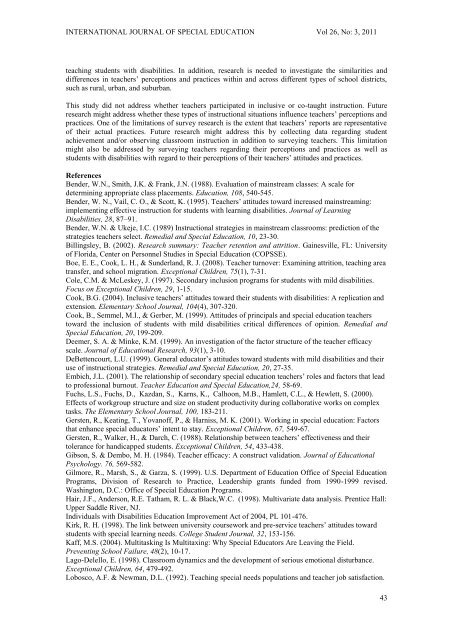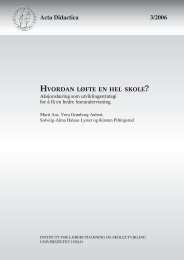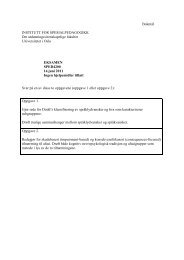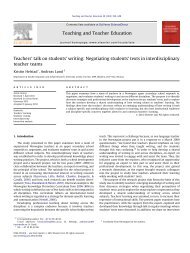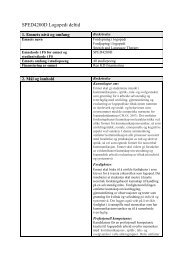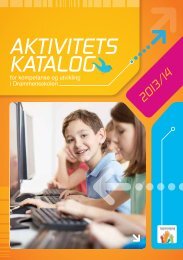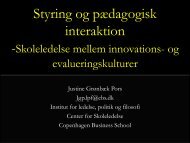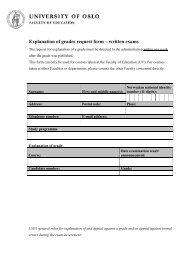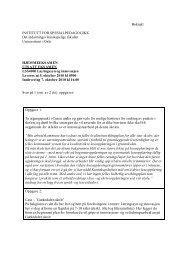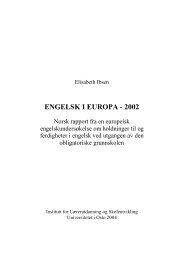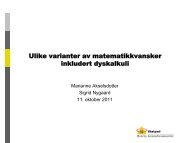International Journal Special Education
International Journal Special Education
International Journal Special Education
Create successful ePaper yourself
Turn your PDF publications into a flip-book with our unique Google optimized e-Paper software.
INTERNATIONAL JOURNAL OF SPECIAL EDUCATION Vol 26, No: 3, 2011teaching students with disabilities. In addition, research is needed to investigate the similarities anddifferences in teachers’ perceptions and practices within and across different types of school districts,such as rural, urban, and suburban.This study did not address whether teachers participated in inclusive or co-taught instruction. Futureresearch might address whether these types of instructional situations influence teachers’ perceptions andpractices. One of the limitations of survey research is the extent that teachers’ reports are representativeof their actual practices. Future research might address this by collecting data regarding studentachievement and/or observing classroom instruction in addition to surveying teachers. This limitationmight also be addressed by surveying teachers regarding their perceptions and practices as well asstudents with disabilities with regard to their perceptions of their teachers’ attitudes and practices.ReferencesBender, W.N., Smith, J.K. & Frank, J.N. (1988). Evaluation of mainstream classes: A scale fordetermining appropriate class placements. <strong>Education</strong>, 108, 540-545.Bender, W. N., Vail, C. O., & Scott, K. (1995). Teachers’ attitudes toward increased mainstreaming:implementing effective instruction for students with learning disabilities. <strong>Journal</strong> of LearningDisabilities, 28, 87–91.Bender, W.N. & Ukeje, I.C. (1989) Instructional strategies in mainstream classrooms: prediction of thestrategies teachers select. Remedial and <strong>Special</strong> <strong>Education</strong>, 10, 23-30.Billingsley, B. (2002). Research summary: Teacher retention and attrition. Gainesville, FL: Universityof Florida, Center on Personnel Studies in <strong>Special</strong> <strong>Education</strong> (COPSSE).Boe, E. E., Cook, L. H., & Sunderland, R. J. (2008). Teacher turnover: Examining attrition, teaching areatransfer, and school migration. Exceptional Children, 75(1), 7-31.Cole, C.M. & McLeskey, J. (1997). Secondary inclusion programs for students with mild disabilities.Focus on Exceptional Children, 29, 1-15.Cook, B.G. (2004). Inclusive teachers’ attitudes toward their students with disabilities: A replication andextension. Elementary School <strong>Journal</strong>, 104(4), 307-320.Cook, B., Semmel, M.I., & Gerber, M. (1999). Attitudes of principals and special education teacherstoward the inclusion of students with mild disabilities critical differences of opinion. Remedial and<strong>Special</strong> <strong>Education</strong>, 20, 199-209.Deemer, S. A. & Minke, K.M. (1999). An investigation of the factor structure of the teacher efficacyscale. <strong>Journal</strong> of <strong>Education</strong>al Research, 93(1), 3-10.DeBettencourt, L.U. (1999). General educator’s attitudes toward students with mild disabilities and theiruse of instructional strategies. Remedial and <strong>Special</strong> <strong>Education</strong>, 20, 27-35.Embich, J.L. (2001). The relationship of secondary special education teachers’ roles and factors that leadto professional burnout. Teacher <strong>Education</strong> and <strong>Special</strong> <strong>Education</strong>,24, 58-69.Fuchs, L.S., Fuchs, D., Kazdan, S., Karns, K., Calhoon, M.B., Hamlett, C.L., & Hewlett, S. (2000).Effects of workgroup structure and size on student productivity during collaborative works on complextasks. The Elementary School <strong>Journal</strong>, 100, 183-211.Gersten, R., Keating, T., Yovanoff, P., & Harniss, M. K. (2001). Working in special education: Factorsthat enhance special educators’ intent to stay. Exceptional Children, 67, 549-67.Gersten, R., Walker, H., & Darch, C. (1988). Relationship between teachers’ effectiveness and theirtolerance for handicapped students. Exceptional Children, 54, 433-438.Gibson, S. & Dembo, M. H. (1984). Teacher efficacy: A construct validation. <strong>Journal</strong> of <strong>Education</strong>alPsychology. 76, 569-582.Gilmore, R., Marsh, S., & Garza, S. (1999). U.S. Department of <strong>Education</strong> Office of <strong>Special</strong> <strong>Education</strong>Programs, Division of Research to Practice, Leadership grants funded from 1990-1999 revised.Washington, D.C.: Office of <strong>Special</strong> <strong>Education</strong> Programs.Hair, J.F., Anderson, R.E. Tatham, R. L. & Black,W.C. (1998). Multivariate data analysis. Prentice Hall:Upper Saddle River, NJ.Individuals with Disabilities <strong>Education</strong> Improvement Act of 2004, PL 101-476.Kirk, R. H. (1998). The link between university coursework and pre-service teachers’ attitudes towardstudents with special learning needs. College Student <strong>Journal</strong>, 32, 153-156.Kaff, M.S. (2004). Multitasking Is Multitaxing: Why <strong>Special</strong> Educators Are Leaving the Field.Preventing School Failure, 48(2), 10-17.Lago-Delello, E. (1998). Classroom dynamics and the development of serious emotional disturbance.Exceptional Children, 64, 479-492.Lobosco, A.F. & Newman, D.L. (1992). Teaching special needs populations and teacher job satisfaction.43


